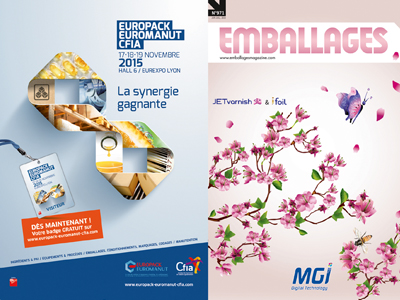MGI usediFoil to bring to life this packaging machine
Creating personalised print embellishments with a digital spot UV coater and in-line hot foil stamping.
Across the printing industry, companies are looking to add value to their printed output and customers are willing to pay more for premium printed products that deliver a real wow factor with the consumer. The doors to adding compelling digital embossing and hot foil stamping effects that achieve this wow factor have recently been opened by MGI – the French manufacturer that brought the Meteor digital press to the market, and that has also developed a range of digital finishing systems.
The most recent of these was the iFoil, which was launched at Ipex in 2014. Working in-line with MGI’s JETvarnish 3D digital spot UV coater (of which 500 have been installed across the world), iFoil makes truly personalised hot foil stamping on an industrial scale cost effective for the first time. There is no need for films, dies and makeready. A job can be printed offset or digitally, then a spot UV varnish applied through the JETvarnish 3D to the areas that require foiling. The sheets then pass through the iFoil unit and the foil is stamped down with a heated roller, sticking to the varnished areas. Run lengths can be one to thousands of sheets, all with variable information picked out in eye-catching high quality foil. Adding another layer of varnish on top of the foil also creates extra interesting effects.
‘Personalised hot foil stamping with iFoil is revolutionary,’ said David Evans, managing director of MGI Technology in the UK. ‘We use the varnish as the glue and because the JETvarnish is a digital machine that makes it possible to get into variable foiling – things like personalised certificates or magazine covers with sequential numbers picked out in foil. This has never been possible before on an industrial scale.’
Additional tactility can also be achieved to enhance the print further, by using the 3D capability of the JETvarnish 3D to build up layers of varnish that result in an embossed effect. The iFoil can then be applied over the top of this to combine the two styles of embellishment.

The JETvarnish 3D with iFoil
A wide range of applications lend themselves to these print enhancements: magazine covers, on demand books, greeting cards, brochures, labels, invitations and packaging can all be given a stunning twist in the shortest of runs. Single copy proofs, not just mock ups, can be cost effectively made up, giving customers a clear indication of what their job will look like.
A key point is that while there are often compromises to be made in making an analogue process digital, this is not the case with the JETvarnish 3D and iFoil combination. MGI says that the quality of foiling is just as good as traditional hot foil stamping, but the digital process actually enables even greater detail and intricacy in the foiling work. Variable data capability and the lack of makeready time and cost required before starting a job make this benefit even more compelling. A new RIP launched for the system also means that variable data jobs can be accepted, set up and processed quickly and easily, without needing to crunch through a multi-page PDF file.
Sterling Solutions in Kettering is the first UK company to have installed the JETvarnish and iFoil technology in its plant, and it has recently been followed by the online stationery printer MOO.
The JETvarnish 3D itself takes digital spot UV coating to a new dimension, with increased throughput for flat spot UV jobs and the amazing 3D raised effects produced by building up layers of varnish. MGI said it is ideal for print operations using offset and/or digital presses up to 520 x 1050 mm format.
It is an inkjet-based system that can apply flat spot UV coating to as many as 3000 B2 sheets per hour (this is faster than the iFoil’s maximum 1700 B2 sheets per hour) and is also able to put down the varnish in variable thicknesses (from eight to 200 microns) on the same document in a single pass. Digital prints can be spot UV coated without any lamination required and the integrated UV curing dries sheets on the fly (if foiling not required). Accuracy is guaranteed, even on jobs with inconsistent registration, through MGI’s Automated Camera Registration (ARC) technology, which can read printed marks and automatically corrects for changes in X and Y parts of the sheet.





